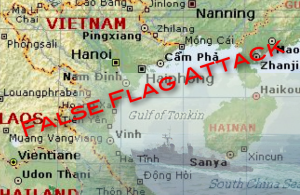
Map; Gulf of Tonkin SOURCE: truth11.files
Posted in The American Legion Magazine
by John Prados – March 1, 2013
The Gulf of Tonkin incident in August 1964 proved to be America’s key entry point to war in Vietnam. The encounter sparked the first open fighting between the United States and North Vietnam, the first U.S. bombing of the North and an intensification of U.S. support for South Vietnam. It led to congressional passage of the Tonkin Gulf Resolution, which became the legal justification for America’s entry in the war. As with so much about Vietnam, events in the Gulf of Tonkin were not what they seemed at the time, and the consequences proved enormous. Even after five decades, we still struggle to understand what happened at the Gulf of Tonkin and why. . . . Read Complete Report
UPDATE: 4/10/2013; Be sure and read the comment posted by Jim Trenor who was in General Quarters in USS Turner Joy’s Combat Information Center during the incident and has a different view of events. He states that the attack did happen. Thanks for your eyewitness information Jim!
~~~~~~~~~~~~~~~~~~~~~~~~~~~~~~~~~~~~~~~~~~~~~~~~~~~~~~~~~~~
From youtube
How To Start A War — (The Covert Strike-First Policy)
Uploaded by Shillwhore
Uploaded on Jun 9, 2008
This secret audio was recorded of Lyndon B. Johnson’s request for a plan to trap Vietnam and force them into a conflict, and 3 weeks later the Gulf of Tonkin incident occurred.
What can we learn from history about how to start a war?
Well, first create an incident where it seams as though you have been attacked, then manipulate the law using the best lawyers and word-smiths you can find to get away with it. . . Read Complete Post







Having been at General Quarters in USS Turner Joy’s Combat Information Center on 4 August 1964 in the Tonkin Gulf, I’d suggest that John Prados’ March 2013 American Legion Magazine article is both inaccurate and highly selective in its use of source materials.
To begin with, even the most cursory review of the official record would reveal that Turner Joy’s commanding officer, Robert C. Barnhart, Jr., was a full commander, not a lieutenant commander, at the time of the incident. Probing further into the record, it’s clear that Task Group Commander Captain John J. Herrick’s expressed doubts about some of the sonar contacts acquired did not negate his overall assessment that an attack on Turner Joy and USS Maddox had occurred. It’s a point emphasized by his post-incident transmission to Barnhart, “Thanks, Bob, for saving my a– out there.”
The declassified NSA records are similarly not a reliable guide. The declassified-in-2005 official NSA history of the event is predicated in part on a 3 September 1964 Agency assessment asserting that North Vietnamese surveillance of the two US destroyers on 3 and particularly 4 August was characterized by “a virtual absence of tracking.” That flies in the face of our shipboard electronic countermeasures equipment’s intercept of transmissions bearing the distinct fingerprints of Soviet-designed radars, including the “Skin Head” installed on at least one Swatow-class patrol boat that was shadowing us on 4 August. It should also be noted that upon declassification of the NSA history, the Agency’s Director of Policy and Records was moved to memo for the record the observation that, the details recounted in the official history notwithstanding, the absence of intercepts indicating plans for or the execution of a North Vietnamese attack did not constitute conclusive proof that an attack did not take place.
It’s not surprising that pilots of supporting US aircraft did not see any PT’s on the moonless, occasionally squally night of 4 August. Post-incident nighttime exercises conducted off of Danang with shipboard-controlled aircraft revealed that pilots were often unable to see “target” PTF’s, even when vectored directly on top of them.
Prados also neglects to mention that a thorough, wholly independent investigation initiated by Commander, Seventh Fleet, concluded that an attack had occurred. What’s notable here is that the lead investigator, an experienced submarine officer who’d previously experienced the weird atmospheric phenomena that sometimes exist in the Tonkin Gulf, was initially a skeptic but concluded after interviewing shipboard eyewitnesses and reviewing all pertinent records of that night that an attack had occurred–and that what two topside eyewitnesses reported as one was in fact a torpedo wake.
The inability of Turner Joy’s AN-SQS-23 sonar to detect the torpedo whose wake was seen was a consequence of that destroyer (and Maddox) steaming evasively at 30 knots, creating interference that effectively masked the torpedo image. During the daytime 2 August engagement between Maddox and three PT’s, several torpedo wakes were seen by Maddox crewmen but also–as indicated in that ship’s after-action report–were not acquired by sonar, probably because in that action Maddox was steaming evasively at 27 knots. That’s a technical detail that’s either ignored or glossed over in accounts such as Prados’.
Other visual evidence of an attack on 4 August–viewed variously by personnel on Turner Joy’s bridge, signal bridge, the deck alongside the forward weapons director, and the aft weapons director–included machine gun fire, a searchlight aimed at us, black smoke emanating from a target we’d taken under fire, and the distinctive silhouette of a Soviet-designed P4 PT boat. There were simply too many diverse and credible indications seen from too many diverse locations to be written off as apparitions viewed by “lying eyes.”
Whatever decision makers chose to do with the information they had, or thought they had, the consequences which flowed from the Tonkin Gulf Resolution should not be allowed to obscure, manipulate, or distort what actually was seen, heard, or otherwise experienced by those of us in the Gulf on 4 August 1964.
First let me thank you for you service during Vietnam.
I also appreciate you taking the time to inform us and our fellow Insiders of your first-hand knowledge of this highly controversial historical moment. I will add a note at the end of the report to make sure that future readers of this article also read your firsthand report. Have you ever written anything on you experience that I could link to?
Thanks again for everything.
Dennis
Thank you for your response and interest, Dennis. I’ve posted a more detailed analysis of the standard historical accounts of the incident (by Edwin Moise and NSA historian Robert Hanyok) at http://jimtranr.com/Whats_Wrong_with_Tonkin_Gulf_Incident_History.html (or, alternately, in PDF format with a .pdf extension).
Jim